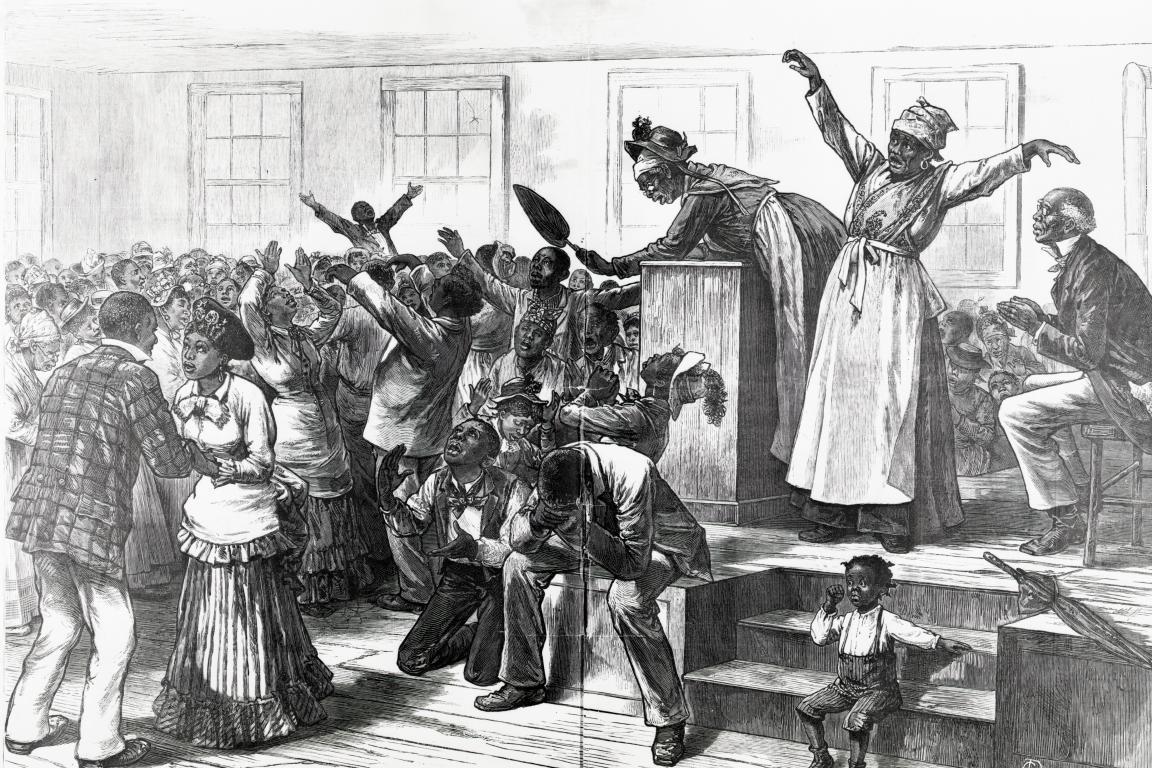Lesson 1: Learning “Kneebone Bend”
Aim: Students will be introduced to ring shout by learning “Kneebone Bend.”
Summary: Students will explore rhythm, call & response and oral tradition by exploring some of the musical layers in “Kneebone Bend.”
Materials: Music Explorers online audio
Standards: GA: ESGMK.CR.1, ESGMK.CR.2, ESGMK.CR.3, ESGMK.PR.1, ESGMK.PR.2, ESGMK.PR.3, ESGMK.RE.1, ESGMK
SC: MGK-2.1, MGK-2.3, MGK-2.4, MGK-2.5, MGK-2.6
Vocabulary: ancestor, baser, call and response, Gullah Geechee, rhythm, ring shout, songster, steady beat, stickman
See Glossary →
Explore Call and Response in “Kneebone Bend”
- The ring shout is part of the Gullah Geechee culture and tradition. Students will learn more about Gullah Geechee culture in Lesson 2.
- Listen to “Kneebone Bend,” Track 03.
Track 03 – Kneebone Bend
- As a class or in small groups ask students to describe and share what they are hearing.
- Have you heard music like this before?
- This song uses call and response. In the ring shout, the leader/caller is the songster and the followers/responders are the basers.
- Using the lyrics on SG11, invite students to sing the response part of the song: “Oh lord, kneebone bend.”
- Students will learn more about the songster role in Lesson 2.
Watch Night
Enslaved people were bought and sold as property and forced to work for another person without pay or basic rights. The song “Kneebone Bend” refers to enslaved Africans first arriving on what is now the coast of Georgia and kneeling down and asking for help in a strange and unfamiliar place.
The evening of December 31st is known as Watch Night, and it refers to the night before enslaved people received word that President Abraham Lincoln signed the Emancipation Proclamation on January 1st, 1863 declaring all enslaved people legally free. This day is commemorated with church services, music, and celebration all through the night.
Learn and Create Rhythmic Patterns in “Kneebone Bend”
- Remind students that the steady pulse you feel in music is called the steady beat. With students, practice keeping a steady beat by lightly tapping your lap, knees, or shoulders.
- Rhythm is a pattern of long and short sounds. The rhythm of a song can change, but the steady beat remains the same.
- Introduce the stickman to your students. The stickman does not have to be gender specific.
- In the ring shout, the stickman taps a long stick (traditionally a broomstick) on a wooden floor. Instead of the steady beat, the stickman plays a rhythmic pattern of long and short sounds that repeats throughout the song.
Track 04 – Stickman Rhythmic Pattern
- Invite students to make their own stick with found materials. Using SG12, use your stick to practice the rhythmic pattern in “Kneebone Bend.” Then use the blank boxes to create your own pattern of long and short sounds to be the stickman.
- Listen to “Kneebone Bend,” Track 03 again and invite students to be the stickman. Basers can also add clapping and foot stomping to the rhythmic layers as they listen and perform.
Track 03 – Kneebone Bend
Creative Extension: Explore Your Family Roots
- Brenton is a part of the McIntosh County Shouters, whose ancestors have been singing songs on the coast of Georgia and South Carolina for hundreds of years. An ancestor is a relative who came before us and helped shape who we are today.
- Brenton explained that he learned ring shout by watching and learning from his older family members, who learned from their ancestors. He also explained that part of being Gullah Geechee is having a strong connection to those family members who came before him.
- As a class or as a home connection, use SG13 to explore what students know about their ancestors, starting with parents and grandparents, and discovering whether any students have family stories that reach further back.
Musical Word Wall
Add the words ancestor, baser, call and response, Gullah Geechee, rhythm, ring shout, songster, steady beat, and stickman to the Musical Word Wall.
See Glossary →
PDF Downloads
SG11 – “Kneebone Bend” Lyrics ↓ Download File
SG12 – Stickman Patterns ↓ Download File
SG13 – What Are Your Roots? ↓ Download File
Audio Tracks
Track 03 – Kneebone Bend
Track 04 – Stickman Rhythmic Pattern

